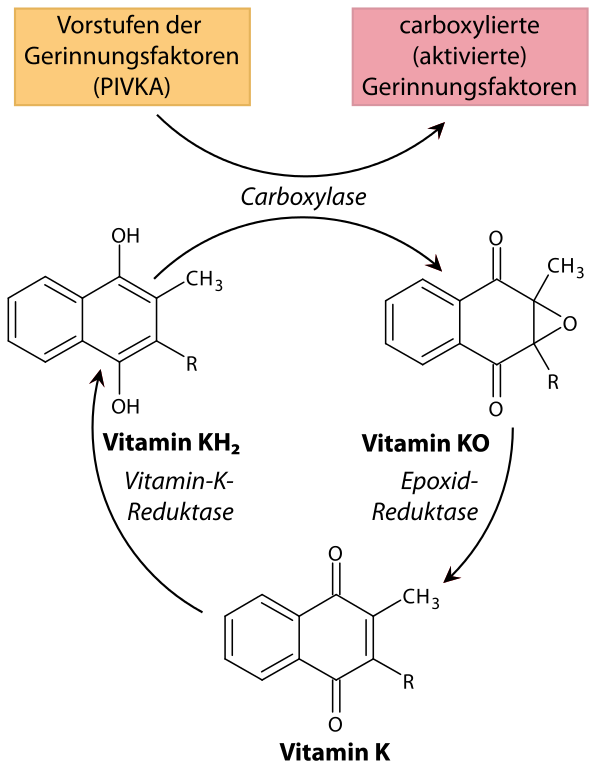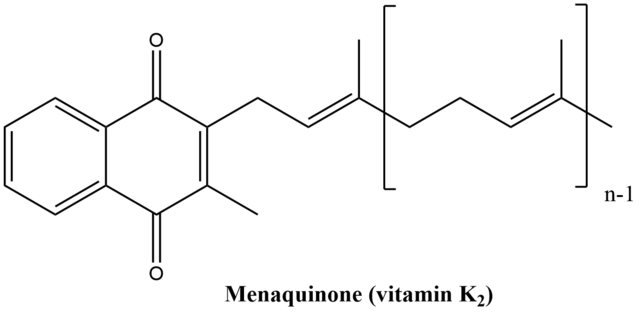Difference Between Vitamin K and K2
What is Vitamin K?
Vitamin K is not a single vitamin, but rather a group of fat-soluble, chemically related vitamins, called with the common name “vitamin K”. Оur bodies store it in the fatty tissue and the liver.
There are 3 forms of vitamin K, known in the biochemistry as naphthoquinones:
- Vitamin K1, phylloquinone, found naturally in certain plant foods;
- Vitamin K2, menaquinone, synthesized from certain bacteria in the digestive tract and delivered by the consumption of certain foods;
- Vitamin K3, menadione, a synthetic form that is not recommended for intake because of a danger of toxicity.
Vitamin K has a number of benefits to the human body:
- Helps normal blood clotting;
- Helps regulate the use of calcium;
- Has a beneficial effect on the arteries and prevents them from calcification;
- Strengthens bones, thus preventing fractures;
- Supports dental health;
- Helps prevent kidney stones;
- Supports growth and development;
- Improves hormonal balance;
- There are indications for prevention of the development of liver and prostate cancer.
The average recommended values for vitamin K intake are 0.08 mg for women and 0.12 mg for men.
The deficiency of vitamin K may have different indications, such as:
- Disturbed normal coagulation with very long hemorrhage after injury;
- Profuse menstrual bleeding;
- Bleeding from the gums and the gastrointestinal tract;
- Blood in the urine;
- Bleeding from the nose;
- Anemia;
- Osteoporosis or osteomalacia;
- Calcification of the blood vessels or heart valves;
- Frequent bone fractures.
There are a number of health problems in the digestive system that can lead to vitamin K deficiency. The use of certain medications, like antibiotics, that destroy normal microflora can also result in vitamin K deficiency.
Good sources of vitamin K are:
- Vegetables and herbaceous plants: spinach, Brussels sprouts, broccoli, cabbage, tomatoes, cucumbers, leeks, kale, etc.
- Vegetable oils: olive oil, soybean oil, sesame oil, rapeseed oil;
- Fruits: apples, potatoes, raspberries, figs, pears;
- Fresh and dried spices: parsley, thyme, marjoram, kelp, curry, etc.
- Dried fruits: blueberries, pears, peaches, figs, etc.
- Legumes: green beans, soy
What is Vitamin K2?
Vitamin K2 (menaquinone), is synthesized from certain bacteria in the digestive tract and is delivered by consuming certain foods of animal origin or fermented foods. Many different types of bacteria in our intestines can produce vitamin K2. Recent data suggest that the endogenously produced (in the human body) vitamin K2 does not play an important biological role. Important is the amount of vitamin K2 that we take with food. The absorption of the vitamin requires the presence of bile acids.
Vitamin K2 is divided into two subcategories:
- MK-4 (menaquinone-4), a short-chain form of vitamin K2 contained in foods of animal origin;
- MK-7 (menaquinone-7), a long-chain form contained in fermented foods (obtained from bacteria during the fermentation process). MK-7 is produced in the fermentation process and has a number of health benefits:
- Stays longer in your body;
- Has a longer half-life.
The benefits of vitamin K2 are:
- Helps regulate the use of calcium;
- Has a beneficial effect on the arteries and prevents them from calcification;
- Strengthens bones, thus preventing fractures;
- Supports dental health;
- Helps prevent kidney stones;
- Supports growth and development;
- Improves hormonal balance;
- There are indications for prevention of the development of liver and prostate cancer.
Deficiency of vitamin K2 may have different indications, such as:
- Osteoporosis or osteomalacia;
- Calcification of the blood vessels or heart valves;
- Frequent bone fractures.
The exact necessary dose of vitamin K is still subject to determination. Currently, it is assumed that about 180-200 micrograms are a sufficient daily dose.
Sources of vitamin K2 are:
- Foods that ferment: Some pickled vegetables, Nato – Japanese soy dish, leavened bread;
- Meat and meat products: chicken, pork, beef, sausages, chicken liver, etc.
- Animal products: eggs, butter, cheese;
- Seafood: oysters, caviar.
Difference Between Vitamin K and K2
-
Definition
Vitamin K: Vitamin K is a group of fat-soluble, chemically related vitamins, known in the biochemistry as naphthoquinones.
Vitamin K2: Vitamin K2 is a fat-soluble vitamin, known in the biochemistry as menaquinone.
-
Dosage
Vitamin K: The average recommended values for vitamin K intake are 0.08 mg for women and 0.12 mg for men.
Vitamin K2: The exact necessary dose of vitamin K is still subject to determination. Currently it is assumed that about 180-200 micrograms are a sufficient daily dose.
-
Forms
Vitamin K: There are 3 forms of vitamin K:
- Vitamin K1, phylloquinone;
- Vitamin K2, menaquinone;
- Vitamin K3, menadione.
Vitamin K2: There are 2 forms of vitamin K2:
- MK-4 (menaquinone-4);
- MK-7 (menaquinone-7).
-
Benefits
Vitamin K: Vitamin K helps to obtain normal blood clotting; helps regulate the use of calcium; has a beneficial effect on the arteries; strengthens the bones; supports dental health; helps prevent kidney stones; supports growth and development; improves hormonal balance. There are indications for prevention of the development of liver and prostate cancer.
Vitamin K2: Vitamin K2 helps regulate the use of calcium, has a beneficial effect on the arteries and prevents them from calcification, strengthens the bones, supports dental health, helps prevent kidney stones, supports growth and development, and improves hormonal balance. There are indications for prevention of the development of liver and prostate cancer.
-
Deficiency
Vitamin K: The deficiency of vitamin K may have different indications, such as disturbed normal coagulation with very long hemorrhage after injury; profuse menstrual bleeding; bleeding from the gums, nose and the gastrointestinal tract; blood in the urine; anemia; osteoporosis or osteomalacia; calcification of the blood vessels or heart valves; frequent bone fractures.
Vitamin K2: The deficiency of vitamin K2 may have different indications, such as osteoporosis or osteomalacia, calcification of the blood vessels or heart valves, frequent bone fractures.
-
Sources
Vitamin K: Good sources of vitamin K are some fruits, vegetables, herbaceous plants, vegetable oils, spices, dried fruits, legumes, fermented foods and animal products.
Vitamin K2: Good sources of vitamin K2 are some fermented foods and animal products.
Vitamin K Vs K2 : Comparison Chart
Summary of Vitamin K and K2
- Vitamin K is a group of fat-soluble, chemically related vitamins, known in the biochemistry as naphthoquinones.
- Vitamin K2 is a fat-soluble vitamin, known in the biochemistry as menaquinone.
- The average recommended values for vitamin K intake are 0.08 mg for women and 0.12 mg for men.. The exact necessary dose of vitamin K is still subject to determination, but it is assumed to be 180-200 micrograms.
- There are 3 forms of vitamin K:
- Vitamin K1, phylloquinone;
- Vitamin K2, menaquinone;
- Vitamin K3, menadione.
- There are 2 forms of vitamin K2:
- MK-4 (menaquinone-4);
- MK-7 (menaquinone-7).
- Vitamin K helps to regulate the normal blood clotting; helps regulate the use of calcium; has a beneficial effect on the arteries; strengthens the bones; supports dental health; helps prevent kidney stones; supports growth and development; improves hormonal balance. There are indications for prevention of the development of liver and prostate cancer. Vitamin K2 has the same benefits, but without the influence on the normal blood clotting.
- Good sources of vitamin K are some fruits, vegetables, herbaceous plants, vegetable oils, spices, dried fruits, legumes, fermented foods and animal products. Good sources of vitamin K2 are some fermented foods and animal products.
- Difference Between Gallstones and Cholecystitis - September 5, 2021
- Difference Between Constipation and Cramping - August 4, 2021
- Difference Between Whole Genome Sequencing and Microarray - May 6, 2021
Search DifferenceBetween.net :
4 Comments
Leave a Response
References :
[0]Image credit: https://upload.wikimedia.org/wikipedia/commons/thumb/9/9c/Menaquinone_%28vitamin_K2%29.png/640px-Menaquinone_%28vitamin_K2%29.png
[1]Image credit: https://upload.wikimedia.org/wikipedia/commons/thumb/7/74/Vitamin-k-zyklus.svg/594px-Vitamin-k-zyklus.svg.png
[2]Harland, T. Vitamin K Levels in Common Foods. Nashville: Dr. Gourmet Books. 2012. Print.
[3]Rheaume-Bleue, K. Vitamin K2 and the Calcium Paradox: How a Little-Known Vitamin Could Save Your Life. Ontario: John Wiley & Sons. 2015. Print.
[4]Suttie, J. Vitamin K in Health and Disease. Boca Raton. CRC Press. 2009. Print.




Very useful
Tyvk for this, Dr. Bozhilova. By way of reciprocation, here’s a reminder of the role of Vit K2, working in the A/V mode in regulating heartbeat. I’ve known several souls who have been spared the need for an artificial pacemaker by its’ daily use of some 50mg, under qualified medical supervision.
What is the target age at which we can give vitamin K2 to for catch up growth. Can u send me more studies on vitamin K2 and its role on my email id
Dr AjayArora
Role of vitK2
Is it dose related
Duration related
Is there any change in final height
Upper age limit for giving vitamin K2